Becoming Real in The Christmas Bunny
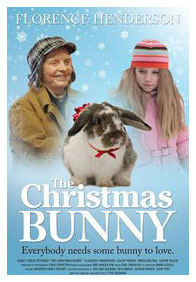
Having just watched Tom Seidman’s The Christmas Bunny (2010) for the first time, my thoughts have drifted back to the vignettes that filled the screens for those of us born before the early 1960s. The Christmas Bunny is a throwback to the television age when each episode of Gunsmoke or Bonanza told a human story about surviving with dignity in this old, wheezing world. No gimmicks or visual excess needed. A simple human story was enough with maybe one standoff between the white and black hats and just a few shots fired. Inspired by Margery Williams’ classic children’s book The Velveteen Rabbit, The Christmas Bunny tells the tale of a troubled girl who finds herself loved for the first time by an ordinary family and so is made “real.” No mystery to the analysis as the film makes the comparison to Williams’ book abundantly clear: little Julia is either reading the book or watching it on video whenever she has time to herself.
Julia’s birth mother has slid into prostitution and drug use and has no strength or will to take care of her, so Julia is in the system and headed to her third home in six months as the story begins. Predictably this is a home where a fair measure of love resides, mainly in the person of the mother, Patti Cooper, a rural crafter with a struggling husband and somewhat bratty son, and no ability to add to her family beyond the foster system. The husband, Scott, has been looking for work and is lingering in self-pity and misguided pride, but he is fundamentally good and encouraged by his wife.
The catalyst for transformation in the film is the “bunny lady,” played by Florence Henderson of Brady Bunch fame, here a reclusive widow who takes care of wounded or lost rabbits on her weathered farm. Her daughter had been her main hand but had left her years before.
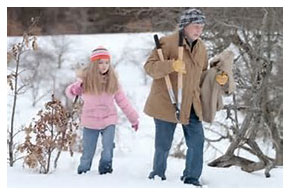
The farm is an icon—the farm, the small family, the fire and rocking chair, and meals where grace is said whether eyes are closed or not, and snow falling faintly and faintly falling over the landscape, Whittier’s America and one still alive though suffocating now in the heavy air of political correctness and urban bias. You know as soon as the agency wagon pulls up to Patti and Scott’s house that this home will become Julia’s salvation, and that the little girl will likewise save those inside. And the bunny lady will save Julia, and Julia will save her.
There is a real “Bunny,” shot in the leg by the bratty son and his insufferable cousin and carried to the bunny lady for help. It, too, will contribute to Julia’s rescue. The bunny is named Rumple, perfect storybook name really for the velveteen rabbit come to life.
That velveteen rabbit knew misery, you know. Thrown in the rubbish pile when the little boy who loved it developed a contagious fever, it appears a goner until rescued and loved again. I read that book to my children dozens of times and not without tears. The truth was and is beautiful. We live to love and find life in loving others; we are made real when undeserved grace is placed on us.
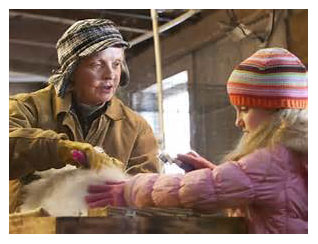
That’s the film’s high concept—little foster girl so miserable she doesn’t speak finds a purpose in caring for an unloved bunny and becomes the purpose for a struggling family and old and lonely widow. Worthy of the side story in a Gunsmoke episode for sure. It moved me, calling up memories, children once again on my knee at night holding the side of some book with fur on the pages you could rub and sniff, books designed as much for parent as the child needing comfort; those memories laced with the story of my own adopted son, neglected then finding life in our home. My son, my son, I think, and there start the tears again.
Julia’s foster-father Scott is lost, too. We see him first cross-country skiing through the woods behind his house; he falls and looks helplessly at the vast and silent sky. Later he will use those skis to find the wandering Julia and her rabbit. These woods are lovely, dark, and deep, and they play a role in the story as the place where dreams are born, the little girl and the father as a man.
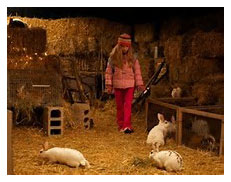
And the woods suggest the Christmas message borne by the title, as they are lonely and in anticipation for the wonder of the deep mid-winter. We all need a walk in those quiet woods—to come alive. It is a theme worthy of all the best short stories: O. Henry’s young lovers selling their treasures to buy precious gifts or Tolstoy’s old shoemaker welcoming in pitiful strangers who are angels or some neighbor taking pity on a young couple with a child on the way and not enough money to bribe the local innkeeper, the neighbor offering a stable and manger to does he ever know whom?
The Christmas Bunny film has a single curiosity, the absence of a typical antagonist. Usually there is someone trying to buy out the local mill or in this case setting a prohibition on the unlicensed rabbit hospital, but none such here. The worst characters are the two bratty boys, but they have no significant part in the larger story of Julia’s transformation to real girl from mute, sullen, loveless. We do get rising action and crisis when Julia wanders from Patti and Scott’s home in search of the bunny lady after an argument between the foster parents that makes her feel all the more unwanted. She is found, of course, by the father Scott as mentioned above; and it is this climactic scene that tips off what has been going on under the surface. The antagonist in the film is Giant Despair. Scott, Julia, and the bunny lady all suffer the same malady of despair, suspicion that there is no God who cares for them and will offer even the little help needed. At a point of desperation in his search, Scott prays for help, just help me find her, God, and we can do the rest.
That prayer might raise questions for anyone familiar with Christian theology since it should end “and I will serve you forever.” But here the father offers just enough to close the loop. God will hear and does and people will heal for now. This is true: people can and do come alive when they are loved. The world came alive through love.
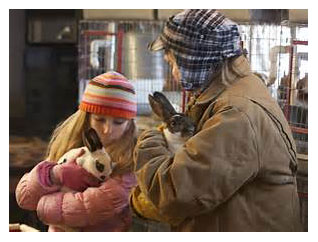
Which makes me wonder if despair, once the existential crisis of modern poets and philosophers, has now spread as a cloud over the hinterland. Is it the malady of my neighbor lady and our mail carrier? Have the common people now lost the belief that events can be orchestrated by heaven for good? Even the worst things, the most pathetic, the grainiest, can be transformed, redeemed—or so we learned once upon a time. And experience reminded us back then that the means for those transformations sometimes hops out of fairyland. It is a bunny in this movie. It was an odd, accidental set of friendships when my life took a hard turn back to forward. Everyone who comes to faith has their own bunny story. But perhaps we have stopped sharing them, a sad and curious matter that the world has become so glum and cynical a place.
The Christmas Bunny is a sweet film with no pretensions of being a clever film, just the quiet confidence that some child will sit in a gentle living room in a whispering house and watch wishing an angel might arrange events so that a lost rabbit and an eccentric old lady and somewhat dysfunctional family can all come together and hold him so close that his heart will start to beat for the first time. Just that wish and nothing more. Just to be made real.
